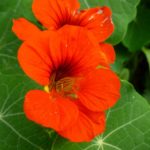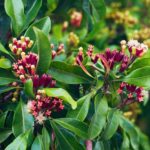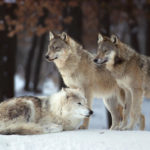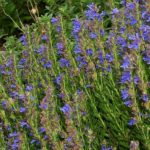Lupine – Types, Landing and care
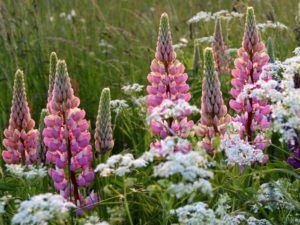 Lupins began to be planted in Russia since the end of the 19th century, as a fodder plant. In those days, few planted them in their gardens for beauty. Today, thanks to the work of breeders, these flowers, which were previously only blue-violet, delight us with white, red, blue and yellow flowers.
Lupins began to be planted in Russia since the end of the 19th century, as a fodder plant. In those days, few planted them in their gardens for beauty. Today, thanks to the work of breeders, these flowers, which were previously only blue-violet, delight us with white, red, blue and yellow flowers.
The name lupine itself is not Russian, but Latin, which means “wolf” in translation. Therefore, the lupins are popularly called “wolf beans.” After all, this is a genus of plants from the legume family.
Lupine is a perennial or annual shrub blooming with tassels with a bright color resembling an ear on high inflorescences. High powerful stalks of lupine grow up to a height of 150 cm. The fleshy core root goes deep into the ground. Beautiful palmate basal leaves consist of 6 to 8 leaves.
Lupine blooms in May and June for a month. But after cutting the peduncles gives repeated flowering in late summer. The leaves are petiolate, palmate. The stem is branched and straight up to one and a half meters high. Modern varieties of moth plants are frost-resistant and winter-hardy. They tolerate the sun, partial shade and any soil. Dipped or bare leathery beans are multi-seeded, which themselves crack as they mature. In the soil, lupine accumulates nitrogen, so it is often used for green manure, as a green fertilizer. In the coloring you can see all the colors of the rainbow, it can be not only monophonic, but also two-tone.
Types of Lupine
Currently, there are more than 200 species of this plant. But three species are considered the most common everywhere – blue narrow-leaved, yellow and white. All species have different seeds in size, shape, color and weight. Alkaloid species began to be superseded by modern varieties, which give a large crop. Every year in London at the exhibition in Chelsea, you can see beautiful specimens of the multi-leafed Russell, Hartweg, hybrid lupine, tree-like. Not so long ago, varieties of non-toxic lupins were developed.
Lupine-Flowers-Planting-and-Care-Growing-Lupine-2
The natural habitat of lupins is considered to be Africa, Central and Southern Europe, Asia and North America. But most of all traces of historical cultural cultivation of lupins are found in Italy, France (also, check Interesting facts about Marseille), Portugal, Tunisia, Algeria. In Egypt, they found the seeds of white lupine in the tomb of the pharaoh and calculated their age – 2000 years BC. Since the 4th century, Greeks have been using lupine beans as a food and feed plant.
Landing and care
In spring, when planting, it is necessary to mulch the soil. On hot summer days, lupins need good watering. In autumn, you need to trim all the stems at the root. Winter-hardy varieties are not afraid of frost. Use fertilizers containing manure or compost. Complex fertilizers are well tolerated by the plant. Try not to transplant the bushes. Since these flowers do not tolerate a transplant.
It does not tolerate lupine soil with a high content of groundwater. It is advisable to plant red, yellow and white varieties away from blue flowers, otherwise all varieties will become dusty and will have only one blue-violet color next year. Experienced gardeners began to grow lupins along with other perennial plants. They are planted in mixborders or edges in the form of background plants in the middle ground. If you plant low grades, then you can use them with the curb method.
Most often, lupine propagates by self-seeding from its own seeds. Therefore, it is better to clean unripe beans. It is better to plant freshly picked seeds in the fall. Some gardeners practice cultivation by cuttings. But we must remember that the cuttings are taken in the spring or at the beginning of the summer season from non-flowering lateral shoots of the plant.
Often farmers use lupine as a feed plant for animals. To do this, even a variety of yellow lupins with non-cracking beans has been specially bred. They have a very high protein content. In the white variety, the amount of protein contains from 29 to 38%, in the blue variety up to 33%. Most of the protein in the yellow species is from 38 to 46%. Fodder lupine is collected from the fields in the form of green mass, which is used to feed livestock. Yields from 300 to 400 centners of green mass and up to fifteen centners of beans per hectare.
Do not forget that the leaves and seeds of lupine have bitter toxic substances. Be careful if using beans as a food or feed plant. Before use, lupins must be soaked in water to remove alkaloids – lupinidine and lupinine. It is not for nothing that they were popularly called “wolf beans.” When taken orally, paralyzing or stimulating effects on the nervous system may occur. Because of their low weight, children are more prone to seed poisoning. Lupinin causes increased salivation, difficulty swallowing, nausea or vomiting, arrhythmia, and a decrease in heart rate. In large doses, paralysis of the limbs and respiratory arrest are possible. There were even fatal cases.



